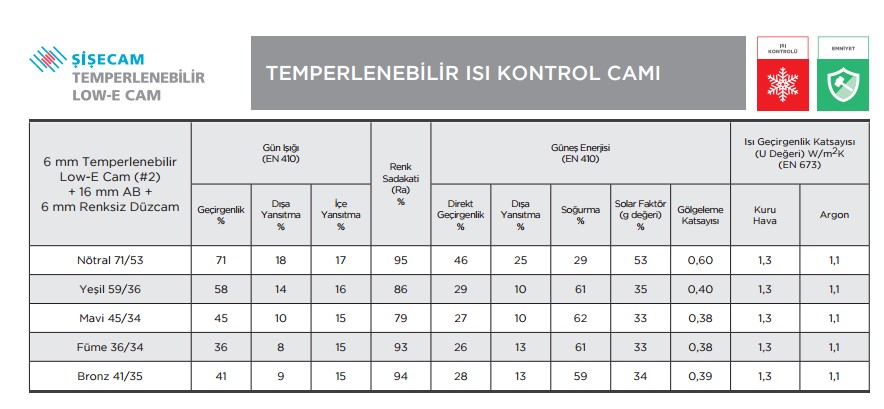TEMPERED LOW-E

Residences, offices, hotels, shopping centers, airports, commercial buildings, skylights and places such as conservatories can be tempered preferred Sisecam Low-E glass, heat control feature provides you with a comfortable living space for users; tempered with the ability to meet the safety requirements. Transparency and projects that come to the forefront of the low reflectivity is preferred.
Low-E Glass can be tempered şişecam is şişecam flat glass can be tempered glass temperature control.
- Temperature control and energy savings.
- It reduces heating costs.
- Transparency and will not budge from natural daylight.
- Architectural expansion of the glass surfaces in buildings and in line with the trend increase in the thickness of the glass meets the safety requirements with nature. When the glass breaks, it eliminates the risk of injury divided into small pieces without sharp.
- Fog delays that occur on the glass surface.
- It provides the maximum benefit from the sun’s heat.
- It prevents the front window of the winter cold.
PRODUCT DESCRIPTION
Low-E Glass can be tempered şişecam is şişecam flat glass can be tempered glass temperature control.
Accredited Isıcam Authorized Manufacturers (II) by double glazing units can be produced using Sisecam Tempering Low-E Glass, Insulating Glass S TAR name on the market.
Tempering can be carried şişecam Low-E Glass Insulating Glass S T, heat losses are reduced by 50% compared to ordinary double glazing and saves heating costs. Tempered, heat control glass, a glass-temper by about 5 times more resistant.
Colors
can be tempered Low-E coating, green on demand as well as my clear float, smoked, can also be applied to bronze and blue tinted glass.
Tempering can şişecam Low-E glass, flat glass in a vacuum by electron scattering method on a thin metal / metal oxide layer line obtained by application of non-coated glass.
“Daylight” and “Solar Energy” values, spectral data measured in the laboratory according to EN 410 standard
using “TNO Science and Industry” – it is calculated at 3:01 WIS software.
The value of the thermal conductivity coefficient was calculated according to standard EN 673 with WIS 3.01.
Emissivity values used in each account, in vitro EN 673 (Appendix A) and measured according to EN 12898.
exposure to solar radiation throughout the surface of the glass piece, the temperature differences between day and night, because of factors such as heat absorption coefficients of the glass of the sexes may arise or chopping risk of thermal breakage.
Depending on these factors require the use of tempered or partially tempered glass.
This document does not have any calculation for thermal breakage risks.
For questions regarding this matter please contact Sisecam Flat Glass.
This document is for informational purposes only and the information it contains without any warning
It changed by Sisecam Flat Glass.
In this document the differences between the actual value depending on the conditions of the place of use with a given value may occur.
Because of these differences Sisecam Flat Glass in no way be held responsible.
Daylight Permeability is the percentage of the light from the window glass.
Daylight Mirror (external): The percentage of incoming light reflected back by the window glass.
Total Solar Energy Transmission: The total percentage of incoming solar energy is coming on the glass.
Lower total solar energy transmittance value, the better the solar control.
Shading Coefficient: Solar energy is compared to the total permeability of 3 mm colorless.
The lower shading coefficient means better solar control.
Thermal Conductivity: the glass is a measure of thermal insulation.
The lower the value, the better the thermal insulation, heating costs and less means more winter comfort.
Get Information for Your New Project
Feel the difference of experienced team and corporate experience



